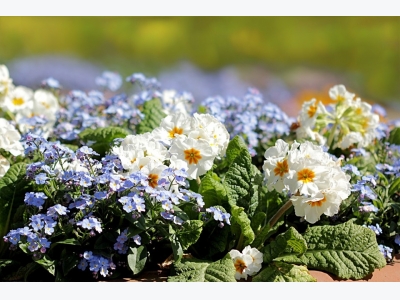How to Grow Flowers: The Ultimate Guide

Whether large or small, every garden deserves some flowers to add color and cheer. And, with hundreds of varieties to choose from, you are sure to find a few that will grow well in your climate.
How do I choose flowers for my climate?
Flowers should be selected based on your USDA plant hardiness zone. This zone map assigns a number to each region of the United States based on data such as average first frost and average annual low temperature. When you buy flowers, look for those labeled for your hardiness zone.
Consider conditions in your region, as well, when choosing flowers. The USDA zone map doesn’t take into account variances in humidity or altitude, so a moisture loving plant, such as a hydrangea might grow very well in humid Illinois, which is zone 5, but would likely struggle in a dry climate like Colorado, which is also zone 5.
Observe the flowers you see growing most often in your neighborhood. These plants are likely well-adapted to your region and require little care. Your local Cooperative Extension Service is also a great resource for recommended varieties. For more information visit:
PlantMaps.com - Interactive Plant Hardiness Zone Maps
USDA - Find Your Local Cooperative Extension Service
BloomIQ - Plant Finder
How do I design my flower beds?
Do you want instant color in a hanging basket or small bed? Annuals live only one season, but grow quickly and are inexpensive to buy. Perennials, on the other hand, grow slowly and cost more initially, but last 20 years or more with proper care and are a good choice for permanent flower beds.
Think about the style of your home and landscape. A multitude of wildflowers looks charming next to a cottage or farmhouse, while more subdued perennials, roses or shrubs work well in a more formal setting.
Choose flowers that provide contrast in a flower bed. For example, you’ll want to include a few tall varieties for the back of the bed and layer smaller plants in the front. Select between four and eight different varieties of plants and use them repeatedly throughout the bed. Using more can make the bed look busy.
See the following for further reading on flower garden design:
Cornell University - Flower Garden Design Basics
Fine Gardening - Redesigning the Backyard
Better Homes & Gardens - Free Garden Plans
Lewis Gardens - Garden Plans Complete with Flowers
How do I plant my flowers?
Most annuals, with the exception of pansies, are easily damaged by frost and are best planted in late spring or early summer. Dormant, bare-root perennials, roses and vines are planted in early spring before new growth emerges, while tender perennials are planted after the last frost. Check with your local nursery expert for guidance on specific planting times.
To make a new flower bed, lay 3 to 4 inches of compost or manure on the soil and dig it in to a depth of 12 inches. This approach may seem a bit drastic, but for perennial beds, especially, your initial efforts will pay off later in healthy, vigorous plants. Annual flowers can get by with less soil prep.
To plant bare-root flowers, remove the wrappings gently and soak the roots in a bucket of water for several hours. Dig a hole large enough to accommodate the roots. Set the plant in the hole and fill the hole half full with soil. Fill the hole with water and allow it to drain before adding the rest of the soil. Tamp the soil gently with your hands to remove any air pockets.
Remove container plants from the pots and gently squeeze the soil to loosen the roots. Set the plants in a hole the same depth, but slightly larger than the roots and fill the hole with soil as described previously. See the following websites for more information on planting flowers:
Kansas State University - Growing Flowers in Pots [PDF]
Howdini.com - How to Plant a Perennial [Video]
Gardeners Supply - How to Plant Annuals from Seeds
How do I care for my flowers?
Newly planted flowers require frequent watering while they grow strong roots and become established. Water them enough to keep the soil evenly moist, but not soggy. Containers also lose moisture quickly, especially on hot days, and may require daily watering.
Mature plants vary widely in the amount of water they need. Sun-loving plants, such as coreopsis, cone flower, Jupiter’s beard, and catmint are quite drought tolerant, while shade-loving plants, such as astilbe, azalea, hydrangeas and bleeding hearts prefer moist soil. Roses also require frequent watering. Check the tag or packet that came with your plant for specific information.
Fertilize perennials in the spring with a balanced 10-10-10 fertilizer, according to package directions. If you have good soil, perennials shouldn’t need additional fertilizer. Too much fertilizer can cause excessive leaf growth at the expense of flower. Don’t fertilize in late summer, which can contribute to winter damage.
Annuals need more frequent fertilizing to support their rapid growth. Feed annuals every two weeks with a water-soluble fertilizer.
Remove faded flowers to keep annual and perennial flowers blooming longer, but save major pruning tasks for late fall or winter when the plant is dormant. Cut out dead or diseased stems and trim back the plant to control its growth.
Related news
 Parts of a Flower
Parts of a Flower Flowers (or blooms, blossoms) are the reproductive part of flowering plants. We commonly think of flowers as the decorative plants that we grow for beauty
 Revitalizing Cheap Plants
Revitalizing Cheap Plants Do you remember the kid back in grade school who would buy sickly goldfish at the pet store,take them home and nurse them back to health and then sell them back
 Simple Garden Fences
Simple Garden Fences You have probably heard the adage that good fences make good neighbors. That’s true not just between people but also between our gardens and the forces